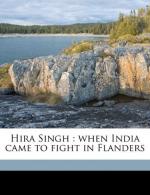We rode for very many days after that, following the course of the Tigris unmolested. The tale Ranjoor Singh told had gone ahead of us. The village Kurds waited to have one look, saw our Turkish prisoners and our Sikh turbans, judged for themselves, and were off! I believe we cost the Turkish garrisons in those parts some grim fighting; and if any Turks were on our trail I dare wager they met a swarm or two of hornets more than they bargained for!
Instead of having to fight our way through that country, we were well received. Wherever we found Kurds, either in tents or in villages, the unveiled women would give us Du, as they call their curds and whey, and barley for our horses, and now and then a little bread. When other persuasion failed, we could buy almost anything they had with a handful or two of cartridges. They were a savage people, but not altogether unpleasing.
Once, where the Tigris curved and our road brought us near the banks, by a high cliff past which the river swept at very great speed, we took part in a sport that cost us some cartridges, but no risk, and gave us great amusement. The Kurds of those parts, having heard in advance of our tale of victory, had decided, to take the nearest loot to hand; so they had made an ambuscade down near the river level, and when we came on the scene we lent a hand from higher up.
Rushing down the river at enormous speed (for the stream was narrow there) forced between rocks with a roar and much white foam the goatskin rafts kept coming on their way to Mosul and Bagdad, some loaded with soldiers, some with officers, and all with goods on which the passengers must sit to keep their legs dry. The rafts were each managed by two men, who worked long oars to keep them in mid-current, they turning slowly round and round.
The mode of procedure was to volley at them, shooting, if possible, the men with oars, but not despising a burst goatskin bag. In case the men with oars were shot, the others would try to take their place, and, being unskilful, would very swifly run the raft against a rock, when it would break up and drown its passengers, the goods drifting ashore at the bend in the river in due time.
On the other hand, when a few goatskin bags were pierced the raft would begin to topple over and the men with oars would themselves direct the raft toward the shore, preferring to take their chance among Kurds than with the rocks that stuck up like fangs out of the raging water. No, sahib, I could not see what happened to them after they reached shore. That is a savage country.
One of our first volleys struck a raft so evenly and all together that it blew up as if it had been torpedoed! We tried again and again to repeat that performance, until Ranjoor Singh checked us for wasting ammunition. It was very good sport. There were rafts and rafts and rafts—KYAKS, I think they call them—and the amount of plunder those Kurds collected on the beach must have been astonishing.




